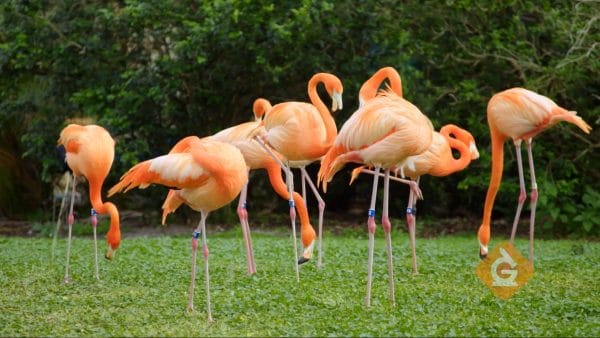Group Behavior Definition
Some animals form groups to help members survive. Animals may work together to find food and defend themselves.
View Lesson on Animal Group Behavior
Become a member to get full access to our entire library of learning videos, reading material, quiz games, simple DIY activities & more.
Become a member to get full access to our entire library of learning videos, quiz games, & more.
Plans & Pricingto watch this full video.

Access All Videos
and Lessons, No Limits.
Access All Videos

No credit card required,
takes 7 sec to signup.
No card required

Ready-to-go lessons
that save you time.
Ready-to-go lessons
If you are on a school computer or network, ask your tech person to whitelist these URLs:
*.wistia.com, fast.wistia.com, fast.wistia.net, embedwistia-a.akamaihd.net
Sometimes a simple refresh solves this issue. If you need further help, contact us.
Animal Group Behavior
Fun Facts
- Geese fly in V-shaped formation to save energy.
- Fish swim in schools for safety from predators.
- Meerkats take turns watching for predators.
Why Do We Need To Know About Group Behavior
Knowing about group behavior helps you see why working together is important. Groups can be different sizes and have different jobs. Pods of whales, swarms of bees, and herds of cattle help each other survive.
Frequently Asked Questions
Check out the Full Lesson on Animal Group Behavior
In this lesson, we learn that:
- Animals form groups to defend themselves.
- Animal Group Behavior can involve a few animals or thousands.
- Groups can help animals get food.
Related Topics
- Adaptation Definition
- Air Mass Definition
- Analog Signal Definition
- Astronomy Definition
- Biomimicry Definition
- Cell Definition
- Circulatory System Definition
- Conservation Definition
- Convection Definition
- Definition Of Shade
- Digital Signal Definition
- Ecosphere Definition
- Ecosystem Definition
- Electric Charge Definition
- Electromagnetic Radiation Definition
- Element Definition
- Engineering Definition
- Food Chain Definition
- Force Definition
- Group Behavior Definition
- Humidity Definition
- Igneous Rock Definition
- Insulator Definition
- Internal Structures Definition
- Kuiper Belt Definition
- Landform Definition
- Light Definition
- Limited Resource Definition
- Liquid Nitrogen Definition
- Marsupial Definition
- Mineral Definition
- Mutualism Definition
- Nervous System Definition
- Non-renewable Energy Definition
- Nucleus Definition
- Ocean Current Definition
- Orbit Definition
- Pattern Definition
- Physical Change Definition
- Potential Energy Definition
- Pull Definition
- Rain Definition
- Smelling Definition
- Solubility Definition
- Water Definition
- Watershed Definition
- Wave Definition
- Wavelength Definition
Start a Free Trial Today. Get a $5 Amazon Gift Card!
Teachers! Start a free trial & we'll send your gift card within 1 day. Only cards left. Try it now.
Select Grade
Select Subject
This email is associated with a Science Kit subscription. Kit subscriptions are managed on this separate page: Manage Subscription

-
Download InvoiceScience & Math$/yr
-
Download InvoiceScience Only$/yr

access all lessons
• No credit card required •
"My students loved the videos. I started the video subscription in May and used them as a review before the state test, which I know contributed to 100% of my class passing the state test."
Rhonda Fox 4th Grade Teacher, Ocala, Florida
Use Generation Genius in Your School
Access all lessons free for 30 days.
"My students loved the videos. I started the video subscription in May and used them as a review before the state test, which I know contributed to 100% of my class passing the state test."
Rhonda Fox 4th Grade Teacher, Ocala, Florida
• No credit card required •
Already a member? Sign In
* no credit card required *

* no credit card required *
* no credit card required *


to Discover the Benefits of Generation Genius
Learn How to Save for Your School & District!

no credit card required
Skip, I will use a 3 day free trial
Enjoy your free 30 days trial
-
Unlimited access to our full library
of videos & lessons for grades K-5. -
You won’t be billed unless you keep your
account open past your 14-day free trial. -
You can cancel anytime in 1 click on the
manage account page or by emailing us.
-
Unlimited access to our full library of videos & lessons for grades K-5.
-
You won't be billed unless you keep your account open past 14 days.
-
You can cancel anytime in 1-click on the manage account page.
Cancel anytime in 1-click on the manage account page before the trial ends and you won't be charged.
Otherwise you will pay just $10 CAD/month for the service as long as your account is open.
Cancel anytime on the manage account page in 1-click and you won't be charged.
Otherwise you will pay $10 CAD/month for the service as long as your account is open.
We just sent you a confirmation email. Enjoy!
DoneWe use cookies to make your experience with this site better. By using this site you agree to our use of cookies. Click "Decline" to delete and block any non-essential cookies for this site on this specific property, device, and browser. Please read our privacy policy for more information on the cookies we use.Learn More
We use cookies to improve your experience. By using this site, you agree to our use of cookies. Click "Decline" to block non-essential cookies. See our privacy policy for details.Learn More




























































































































